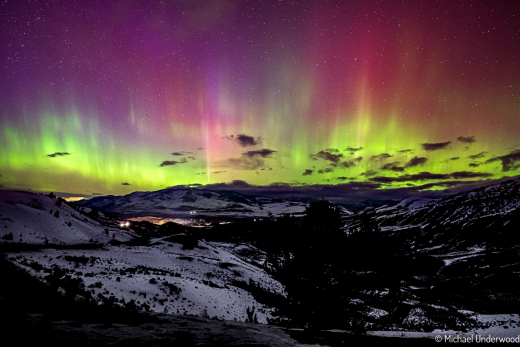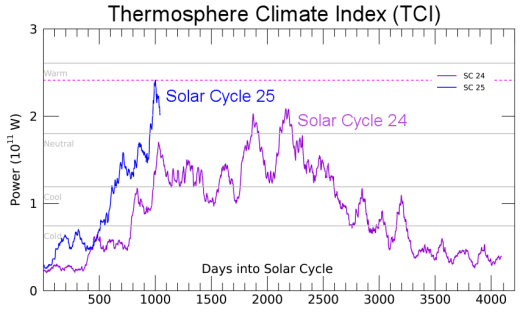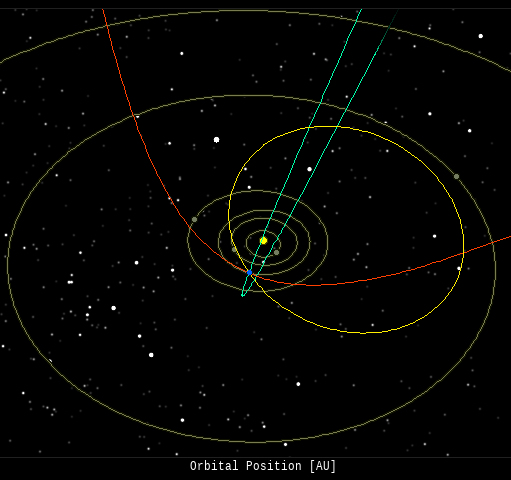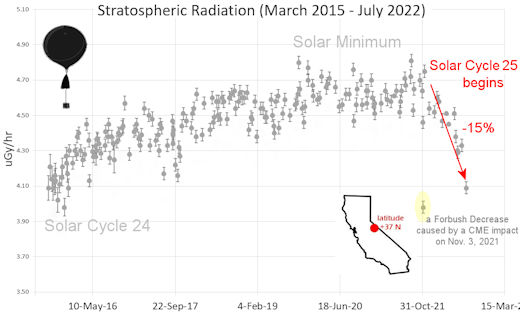Text created by ChatGPT and other Large Language Models is spreading rapidly across the Internet. It's well-written, artificial, frequently inaccurate. If you find a mistake on Spaceweather.com, rest assured it was made by a real human being. This is an AI Free Zone! | | |
MINOR GEOMAGNETIC STORM WATCH (UPDATED): NOAA forecasters say that minor G1-class geomagnetic storms are possible on June 3rd when a stream of solar wind is expected to hit Earth's magnetic field. Originally predicted to arrive on June 2nd, the gaseous material is flowing slower than expected from a pair of holes in the sun's atmosphere. Aurora alerts: SMS Text
THE THERMOSPHERE IS HEATING UP: If you're a satellite, this story is important. A series of geomagnetic storms in 2023 has pumped terawatts of energy into Earth's upper atmosphere, helping to push its temperature and height to a 20-year high. Air surrounding our planet is now touching satellites in Earth orbit and dragging them down.
"Blame the sun," says Martin Mlynczak of NASA Langley. "Increasing solar activity is heating the top of the atmosphere. The extra heat has no effect on weather or climate at Earth's surface, but it's a big deal for satellites in low Earth orbit."

Above: A severe geomagnetic storm on March 24, 2023, photographed by Michael Underwood from Yellowstone National Park
Mlynczak is an expert on the temperature up there. For 20 years he has been using the SABER instrument on NASA's TIMED satellite to monitor infrared emissions from "the thermosphere," the uppermost layer of the atmosphere.
"Right now we’re seeing some of the highest readings in the mission's 21.5 year history," he says.
The thermosphere is exquisitely sensitive to solar activity, readily absorbing energy from solar flares and geomagnetic storms. These storms have been coming hard and fast with the recent rise of Solar Cycle 25.
"There have been five significant geomagnetic storms in calendar year 2023 that resulted in marked increases in the amount of infrared radiation (heat) in Earth's thermosphere," says Mlynczak. "They peaked on Jan. 15th (0.59 TW), Feb. 16th (0.62 TW), Feb. 27th (0.78 TW), Mar. 24th (1.04 TW), and April 24th (1.02 TW)."
The parenthetical values are TeraWatts (1,000,000,000,000 Watts) of infrared power observed by SABER during each storm. The sensor obtains these numbers by measuring infrared radiation emitted from nitric oxide and carbon dioxide molecules in the thermosphere.

Above: NASA's daily Thermosphere Climate Index tracks thermal energy in Earth's upper atmosphere. So far, Solar Cycle 25 is far ahead of Solar Cycle 24. Credit: Linda Hunt
"The two storms exceeding 1 TW are the seventh and eighth strongest storms observed by SABER over the past 21.5 years," he says. "It is interesting to note that each successive storm in 2023 is generally stronger than its predecessors."
Actually, it doesn't take a strong storm to cause problems. In Feb. 2022, a minor geomagnetic storm dumped enough heat into the thermosphere that 38 newly launched Starlink satellites fell out of the sky. SpaceX has since started launching their Starlinks to higher initial altitudes to avoid the drag.
If current trends continue, the thermosphere will warm even more in 2023 and 2024. This is a matter of concern because Earth's population of active satellites has tripled since SpaceX started launching Starlinks in 2019. The growing constellation of 4100 Starlinks now provides internet service to more than a million customers. An extreme geomagnetic storm like the Halloween Storms of 2003 could shift the positions of these satellites by many 10s of kilometers, increasing the risk of collisions and causing some of the lowest ones to de-orbit.
Stay tuned as the warming continues.
Realtime Space Weather Photo Gallery
Free: Spaceweather.com Newsletter
FAR-OUT FATHER'S DAY GIFT: Have you ever wished your dad smelled like Jean-Luc Picard? Make it Soap! Scented like Earl Grey tea, this bar of soap flew to the stratosphere on May 26, 2023, onboard an Earth to Sky Calculus cosmic ray balloon:

You can have it for $99.95. The students of Earth to Sky are selling space soap to support their cosmic ray ballooning program. Each bar comes with a greeting card showing the soap in flight and telling the story of its journey to the stratosphere and back again.
Far Out Gifts: Earth to Sky Store
All sales support hands-on STEM education
Realtime Aurora Photo Gallery
Free: Spaceweather.com Newsletter
Every night, a network of
NASA all-sky cameras scans the skies above the United States for meteoritic fireballs. Automated software maintained by NASA's Meteoroid Environment Office calculates their orbits, velocity, penetration depth in Earth's atmosphere and many other characteristics. Daily results are presented here on Spaceweather.com.
On Jun 03, 2023, the network reported 3 fireballs.
(3 sporadics)

In this diagram of the inner solar system, all of the fireball orbits intersect at a single point--Earth. The orbits are color-coded by velocity, from slow (red) to fast (blue). [Larger image] [movies]
Potentially Hazardous Asteroids (
PHAs) are space rocks larger than approximately 100m that can come closer to Earth than 0.05 AU. None of the known PHAs is on a collision course with our planet, although astronomers are finding
new ones all the time.
On June 3, 2023 there were 2335 potentially hazardous asteroids.
 |
Recent & Upcoming Earth-asteroid encounters: | Asteroid | Date(UT) | Miss Distance | Velocity (km/s) | Diameter (m) |
| 2023 KV3 | 2023-May-29 | 1.2 LD | 11.1 | 8 |
| 2021 KO2 | 2023-May-29 | 15.8 LD | 13.9 | 9 |
| 2023 JZ4 | 2023-May-29 | 6 LD | 16.1 | 34 |
| 2023 KT4 | 2023-May-30 | 8.1 LD | 8.1 | 17 |
| 2023 KT1 | 2023-May-30 | 10 LD | 7.8 | 23 |
| 2012 KP24 | 2023-May-31 | 10.3 LD | 12.4 | 19 |
| 2023 KE5 | 2023-Jun-01 | 5.9 LD | 8.5 | 25 |
| 2023 JM1 | 2023-Jun-01 | 10.1 LD | 5.1 | 23 |
| 2023 KZ2 | 2023-Jun-02 | 12.4 LD | 9.3 | 20 |
| 2023 KS2 | 2023-Jun-02 | 10.3 LD | 10.3 | 22 |
| 2023 JE5 | 2023-Jun-04 | 17.6 LD | 8 | 35 |
| 2023 JR2 | 2023-Jun-04 | 17 LD | 7.6 | 38 |
| 2023 HO18 | 2023-Jun-04 | 1.2 LD | 4.7 | 30 |
| 2023 KW2 | 2023-Jun-06 | 11.8 LD | 10.1 | 65 |
| 2018 KR | 2023-Jun-07 | 6.5 LD | 4.9 | 19 |
| 2017 UJ2 | 2023-Jun-07 | 5.3 LD | 5.6 | 2 |
| 2023 JB3 | 2023-Jun-09 | 14.1 LD | 6.9 | 52 |
| 488453 | 2023-Jun-12 | 8.3 LD | 21.5 | 495 |
| 2022 WN4 | 2023-Jun-13 | 10.8 LD | 15.1 | 158 |
| 2020 DB5 | 2023-Jun-15 | 11.3 LD | 9.5 | 506 |
| 2023 HL | 2023-Jun-17 | 13.5 LD | 1 | 15 |
| 2016 LK49 | 2023-Jun-19 | 17.4 LD | 19.4 | 22 |
| 2023 HF1 | 2023-Jun-21 | 12.5 LD | 4.4 | 59 |
| 467336 | 2023-Jun-24 | 17.4 LD | 7.1 | 269 |
| 2008 LG2 | 2023-Jun-24 | 10.5 LD | 5.6 | 32 |
| 2013 WV44 | 2023-Jun-28 | 9.1 LD | 11.8 | 95 |
| 2022 MM1 | 2023-Jun-29 | 9.5 LD | 9.8 | 41 |
| 2020 NC | 2023-Jul-02 | 13.9 LD | 7.7 | 123 |
| 2023 HO6 | 2023-Jul-05 | 5.3 LD | 7.8 | 241 |
| 2019 LH5 | 2023-Jul-07 | 14.9 LD | 21.6 | 281 |
| 2018 NW | 2023-Jul-10 | 18 LD | 21.8 | 10 |
| 2018 UY | 2023-Jul-12 | 7.4 LD | 16.4 | 243 |
| 2020 UQ3 | 2023-Jul-18 | 3.2 LD | 9.3 | 59 |
| 2022 GX2 | 2023-Jul-20 | 11.9 LD | 9.4 | 5 |
| 2020 OM | 2023-Jul-20 | 8.5 LD | 9.5 | 14 |
| 2015 MA54 | 2023-Jul-24 | 16.6 LD | 9.2 | 31 |
| 2018 BG5 | 2023-Jul-27 | 10.7 LD | 8.4 | 56 |
| 2020 PP1 | 2023-Jul-29 | 17 LD | 4.1 | 17 |
| 2021 BD3 | 2023-Jul-30 | 14 LD | 8.5 | 25 |
| 2016 AW65 | 2023-Jul-31 | 16.6 LD | 5.7 | 54 |
Notes: LD means "Lunar Distance." 1 LD = 384,401 km, the distance between Earth and the Moon. 1 LD also equals 0.00256 AU. | | Cosmic Rays in the Atmosphere |
SPACE WEATHER BALLOON DATA: Almost once a week, Spaceweather.com and the students of Earth to Sky Calculus fly space weather balloons to the stratosphere over California. These balloons are equipped with sensors that detect secondary cosmic rays, a form of radiation from space that can penetrate all the way down to Earth's surface. Our monitoring program has been underway without interruption for 7 years, resulting in a unique dataset of in situ atmospheric measurements.
Latest results (July 2022): Atmospheric radiation is decreasing in 2022. Our latest measurements in July 2022 registered a 6-year low:

What's going on? Ironically, the radiation drop is caused by increasing solar activity. Solar Cycle 25 has roared to life faster than forecasters expected. The sun's strengthening and increasingly tangled magnetic field repels cosmic rays from deep space. In addition, solar coronal mass ejections (CMEs) sweep aside cosmic rays, causing sharp reductions called "Forbush Decreases." The two effects blend together to bring daily radiation levels down.
.Who cares? Cosmic rays are a surprisingly "down to Earth" form of space weather. They can alter the chemistry of the atmosphere, trigger lightning, and penetrate commercial airplanes. According to a study from the Harvard T.H. Chan school of public health, crews of aircraft have higher rates of cancer than the general population. The researchers listed cosmic rays, irregular sleep habits, and chemical contaminants as leading risk factors. A number of controversial studies (#1, #2, #3, #4) go even further, linking cosmic rays with cardiac arrhythmias and sudden cardiac death.
Technical notes: The radiation sensors onboard our helium balloons detect X-rays and gamma-rays in the energy range 10 keV to 20 MeV. These energies span the range of medical X-ray machines and airport security scanners.
Data points in the graph labeled "Stratospheric Radiation" correspond to the peak of the Regener-Pfotzer maximum, which lies about 67,000 feet above central California. When cosmic rays crash into Earth's atmosphere, they produce a spray of secondary particles that is most intense at the entrance to the stratosphere. Physicists Eric Regener and Georg Pfotzer discovered the maximum using balloons in the 1930s and it is what we are measuring today.
| | The official U.S. government space weather bureau |
| | The first place to look for information about sundogs, pillars, rainbows and related phenomena. |
| | Researchers call it a "Hubble for the sun." SDO is the most advanced solar observatory ever. |
| | 3D views of the sun from NASA's Solar and Terrestrial Relations Observatory |
| | Realtime and archival images of the Sun from SOHO. |
| | information about sunspots based on the latest NOAA/USAF Active Region Summary |
| | current counts of failed and deployed Starlink satellites from Jonathan's Space Page |
| | Authoritative predictions of space junk and satellite re-entries |
| | from the NOAA Space Environment Center |
| | fun to read, but should be taken with a grain of salt! Forecasts looking ahead more than a few days are often wrong. |
| | from the NOAA Space Environment Center |
| | the underlying science of space weather |
 | Getting YouTube comments is essential if you want to beat the algorithm! That’s why you need to buy YouTube comments from RealSocialz.com because they offer real USA comments you can customize. |
 | When looking for casinos to play online when the weather is bad, you can try casino online trucchi for Italian games. If you are not from Finland you can try the Swedish page Svenska casino online to find suitable games, check out svenskacasinoonline.net. Always check your local laws before playing with real money. |
 | BestCSGOGambling is the best site for everything related to CSGO gambling on the web |
| | These links help Spaceweather.com stay online. Thank you to our supporters! |
| | | | | | |

